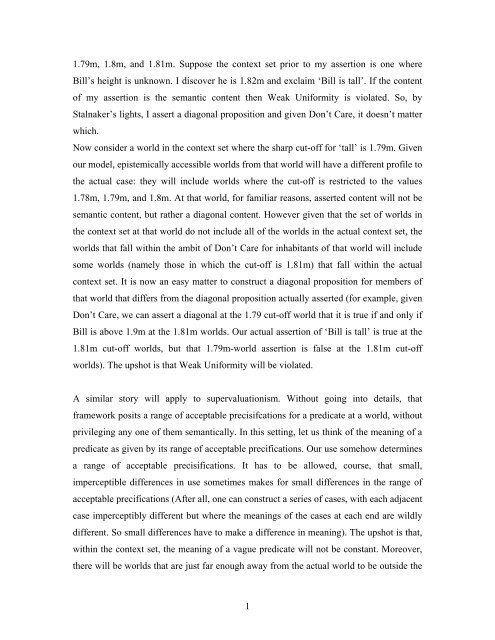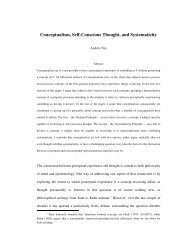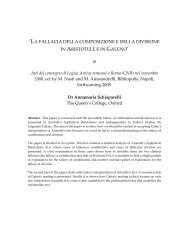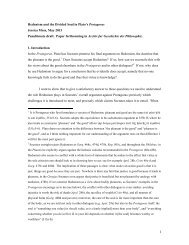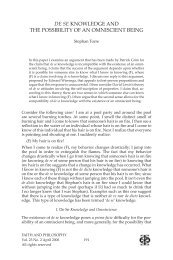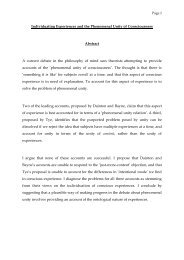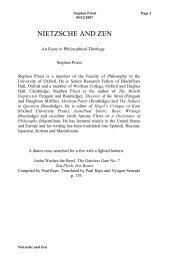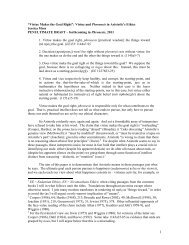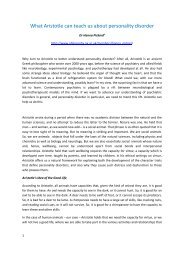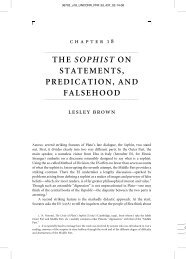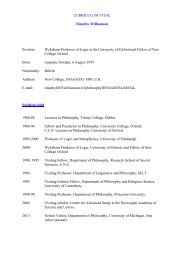In 'Assertion', Robert Stalnaker distinguishes between the sema
In 'Assertion', Robert Stalnaker distinguishes between the sema
In 'Assertion', Robert Stalnaker distinguishes between the sema
Create successful ePaper yourself
Turn your PDF publications into a flip-book with our unique Google optimized e-Paper software.
1.79m, 1.8m, and 1.81m. Suppose <strong>the</strong> context set prior to my assertion is one where<br />
Bill’s height is unknown. I discover he is 1.82m and exclaim ‘Bill is tall’. If <strong>the</strong> content<br />
of my assertion is <strong>the</strong> <strong>sema</strong>ntic content <strong>the</strong>n Weak Uniformity is violated. So, by<br />
<strong>Stalnaker</strong>’s lights, I assert a diagonal proposition and given Don’t Care, it doesn’t matter<br />
which.<br />
Now consider a world in <strong>the</strong> context set where <strong>the</strong> sharp cut-off for ‘tall’ is 1.79m. Given<br />
our model, epistemically accessible worlds from that world will have a different profile to<br />
<strong>the</strong> actual case: <strong>the</strong>y will include worlds where <strong>the</strong> cut-off is restricted to <strong>the</strong> values<br />
1.78m, 1.79m, and 1.8m. At that world, for familiar reasons, asserted content will not be<br />
<strong>sema</strong>ntic content, but ra<strong>the</strong>r a diagonal content. However given that <strong>the</strong> set of worlds in<br />
<strong>the</strong> context set at that world do not include all of <strong>the</strong> worlds in <strong>the</strong> actual context set, <strong>the</strong><br />
worlds that fall within <strong>the</strong> ambit of Don’t Care for inhabitants of that world will include<br />
some worlds (namely those in which <strong>the</strong> cut-off is 1.81m) that fall within <strong>the</strong> actual<br />
context set. It is now an easy matter to construct a diagonal proposition for members of<br />
that world that differs from <strong>the</strong> diagonal proposition actually asserted (for example, given<br />
Don’t Care, we can assert a diagonal at <strong>the</strong> 1.79 cut-off world that it is true if and only if<br />
Bill is above 1.9m at <strong>the</strong> 1.81m worlds. Our actual assertion of ‘Bill is tall’ is true at <strong>the</strong><br />
1.81m cut-off worlds, but that 1.79m-world assertion is false at <strong>the</strong> 1.81m cut-off<br />
worlds). The upshot is that Weak Uniformity will be violated.<br />
A similar story will apply to supervaluationism. Without going into details, that<br />
framework posits a range of acceptable precisifcations for a predicate at a world, without<br />
privileging any one of <strong>the</strong>m <strong>sema</strong>ntically. <strong>In</strong> this setting, let us think of <strong>the</strong> meaning of a<br />
predicate as given by its range of acceptable precifications. Our use somehow determines<br />
a range of acceptable precisifications. It has to be allowed, course, that small,<br />
imperceptible differences in use sometimes makes for small differences in <strong>the</strong> range of<br />
acceptable precifications (After all, one can construct a series of cases, with each adjacent<br />
case imperceptibly different but where <strong>the</strong> meanings of <strong>the</strong> cases at each end are wildly<br />
different. So small differences have to make a difference in meaning). The upshot is that,<br />
within <strong>the</strong> context set, <strong>the</strong> meaning of a vague predicate will not be constant. Moreover,<br />
<strong>the</strong>re will be worlds that are just far enough away from <strong>the</strong> actual world to be outside <strong>the</strong><br />
1


